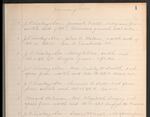Block 14 is something of a mystery to the staff that oversee Portland’s Lone Fir Cemetery.
The gravel lot, which spans a little more than an acre of the otherwise lush cemetery, was used throughout the late 1800s to bury people who died while in the care of the Hawthorne Asylum a few blocks away. Years later, it became a common burial spot for the city's Chinese immigrants.
But poor record-keeping and careless burial practices mean basic details about the lives of those buried in the lot — names, dates of death, where exactly the bodies were laid to rest — are hard to find.
Metro, the regional government for the Portland area, wants to reclaim the history of marginalized people buried inside its historic cemeteries with a new research project, greenlighted for funding by the Oregon Heritage Commission on Monday.
The project, meant to honor the upcoming 100th anniversary of women’s suffrage, will have a staff member dig into Metro's 60,000 records, and create a public exhibit that showcases the lives of “women who were institutionally neglected and even harmed,” according to the grant proposal.
The exhibit will focus largely on the stories of the women buried in Block 14 of Lone Fir, as well as those who ended up in the Multnomah Park Cemetery.
Juan Carlos Ocaña-Chíu, who will lead the program as Metro’s parks and nature business services manager, said they included Multnomah Park because it was the designated burial site for the city’s Morningside Asylum, where many Alaskan women were sent throughout the first half of the 20th century.

A page from a burial book with the Lone Fir Cemetery.
Courtesy of Juan Carlos Ocaña-Chíu
At the time, mental illness was a crime and Alaska, still a territory, didn’t have services for those it convicted. Metro estimates the federal government sent more than 3,500 Alaskans to the asylum, many of them women committed for “hysteria.”
Ocaña-Chíu said he’s recently received requests from Alaskan residents looking to find out more about their relatives who were sent to Portland more than half a century ago.
With a trove of burial books, property deeds, death certificates, and even old letters and newspaper clippings, Ocaña-Chíu said Metro’s cemeteries are the right place to look.
“We see cemeteries not only as a place for quiet reflection and contemplation and remembrance of the people who are buried there,” he said. “But we also see them as living history places where the community can connect with the stories of the past.”
According to the proposal, Metro is planning a public celebration at Lone Fir Cemetery during the second half of 2020, which the agency said will feature speeches and living history performances.
